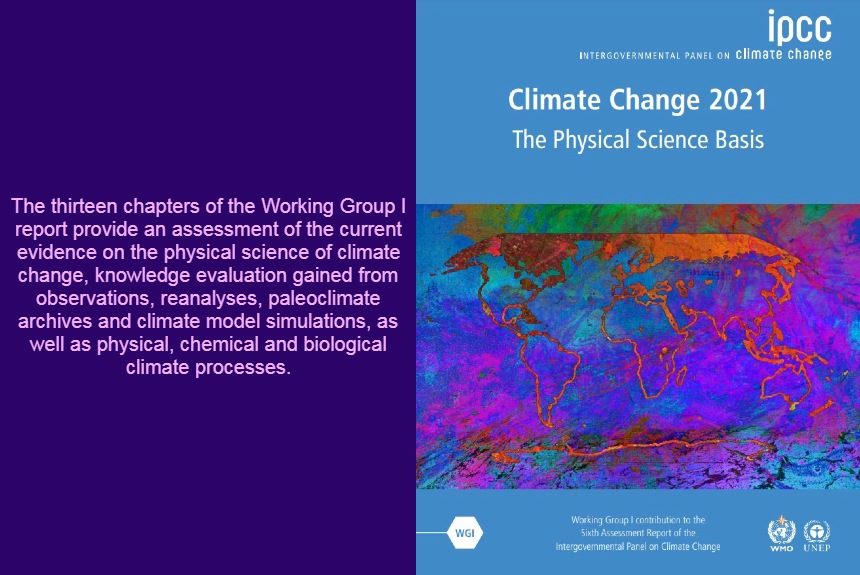The Intergovernmental Panel on Climate Change (IPCC) released The “AR6 Climate Change 2021: The Physical Science Basis” on 9th August 2021.
This report is the most comprehensive assessment of scientific knowledge and identifies human-caused climate change’s present and future threats.
According to the IPCC, the Sixth Assessment Report or AR6, “addresses the most up-to-date physical understanding of the climate system and climate change, bringing together the latest advances in climate science, and combining multiple lines of evidence from paleoclimate, observations, process understanding, and global and regional climate simulations.”
The AR6 consists of four reports, namely:
- The Physical Science Basis,
- Impacts, Adaptation & Vulnerability,
- Mitigation of Climate Change, and the
- Synthesis Report – final report that builds on the findings from all three reports.
Hundreds of scientists prepare the report voluntarily to assess all evidence from scientific, technical, and socio-economic publications. Successive are drafts sent to government leaders and experts for review under a rigorous, robust, and transparent process.
The final draft will inform policymakers what scientists know about climate change which is important in domestic and international policy-making and global climate negotiations.
What does the Physical Science Basis report say?
The report is unequivocal – human activities have caused an unprecedented and irreversible change to the climate. Over the past decade, we have ignored warnings from climate scientists that have become a reality – wildfires in California, Greece, and Turkey, floods in China, Germany and England, and heatwaves in Canada and Siberia as just a foretaste of what is to come.
Temperatures will likely rise to 1.5°C, a catastrophic limit that world leaders have promised to avoid by 2030, earlier than most people have expected.
Authors say that since 1970 global surface temperatures have rapidly increased compared to any other 50 year period in the last 2000 years. This warming is affecting weather and climate extremes in every region in the world.
For every additional 0.5°C increase in warming, there are detectable increases in the intensity and frequency of droughts, heatwaves, heavy rainfall and extreme weather events.
The warming also has altered many planetary support systems that can be irreversible for hundreds and thousands of years.
Oceans will continue to warm and become more acidic. Mountain and polar glaciers will continue to melt for decades or centuries.
Sea level rise of around 2 metres by the end of this century can happen. A 5-metre increase by 2100 could completely submerge coastal areas and pacific islands, threatening millions of people.
Dr. Friederike Otto, from the University of Oxford, UK, and one of the IPCC report’s authors, says that “We will see even more intense and more frequent heatwaves, and we will also see an increase in heavy rainfall events on a global scale, and also increases in some types of droughts in some regions of the world” (McGrath, 2021).
What will the future look like?
An increase in extreme events will be “unprecedented in the historical record” even with a 1.5°C warming.
Extreme sea-level events that are considered one-in-a-century is projected to occur at least yearly by 2100.
There will be increases in wildfires in many regions.
What we can do?
Immediate action is needed to limit temperature increases to 1.5 degrees to avoid more catastrophic climate change. While this is challenging, we need to halve the total global emission by 2030 and bring CO2 emissions to net zero in the next 30 years. The report should be a “death knell” for coal and fossil fuels before they destroy our planet, says António Guterres, the UN secretary-general (Carrington, 2021).
Reaching net-zero will involve boosting the uptake of clean technology while implementing the carbon capture storage technology to store away any emissions or use trees to absorb them.
Countries will need to step up with their Nationally Determined Contributions (NDCs) and ensure governments implement what it says. “Too many ‘net-zero’ climate plans have been used to greenwash pollution and business as usual,” says Teresa Anderson at ActionAid International (Carrington, 2021).
To view the full report and summary for policymakers, please click the specific button below:
Would you please watch this video for further information on IPCC’s Sixth Assessment Report?
What is IPCC’s Sixth Assessment Report? from IPCC on Vimeo.
Source Citation:
IPCC, 2021: Summary for Policymakers. In: Climate Change 2021: The Physical Science Basis. Contribution of Working Group I to the Sixth Assessment Report of the Intergovernmental Panel on Climate Change [Masson-Delmotte, V., P. Zhai, A. Pirani, S. L. Connors, C. Péan, S. Berger, N. Caud, Y. Chen, L. Goldfarb, M. I. Gomis, M. Huang, K. Leitzell, E. Lonnoy, J.B.R. Matthews, T. K. Maycock, T. Waterfield, O. Yelekçi, R. Yu and B. Zhou (eds.)]. Cambridge University Press. In Press.
McGrath. M. (2021, 9 August). Climate Change: IPCC report is ‘code red for humanity’. BBC News. Retrieved from https://www.bbc.com/news/science-environment-58130705
Carrington, D. (2021, 9 August). IPCC report’s verdict on climate crimes of humanity: guilty as hell. The Guardian. Retrieved from https://www.theguardian.com/environment/2021/aug/09/ipcc-reports-verdict-on-climate-crimes-of-humanity-guilty-as-hell



Leave a Reply